sercan85,
Nice looking pictures. Hope it would be okay if I ask a few questions
1. What regulators power AVCC_L and AVCC_R?
2. Wondering what you are using for MCLK source?
3. What DPLL settings are typically used?
4. From the pictures it looks like op amps are AD797?
Thanks,
Mark
Dear mark;
1- ı using for avcc lt3045 0,56uV noise 3,3v regulator from diyinhk, I did4 quad lt3045 0,4uv regulator for my project but bealive me 2cuoz pcb panasonic capacitors wima capacitors more expencive from diyinhk...
2- İ using crytek CCHD-950-25-100 for mclk, but i see on mouser CCHD-950X-25-100 only different temp. X version 0-85c ı can use it other project.
3-DPLL setting high mode for es9028pro but my old dac es90218s need to highest bcoz when i play 192khz or 352khz if dpll low i have lock problem... But 9028pro so good
4-AD797 is amazing for ess dac... bealive me i spen so much money for opamp, i try many opamp and always turn back AD797....
thanks
Dear mark;
1- ı using for avcc lt3045 0,56uV noise 3,3v regulator from diyinhk, I did4 quad lt3045 0,4uv regulator for my project but bealive me 2cuoz pcb panasonic capacitors wima capacitors more expencive from diyinhk...
2- İ using crytek CCHD-950-25-100 for mclk, but i see on mouser CCHD-950X-25-100 only different temp. X version 0-85c ı can use it other project.
3-DPLL setting high mode for es9028pro but my old dac es90218s need to highest bcoz when i play 192khz or 352khz if dpll low i have lock problem... But 9028pro so good
4-AD797 is amazing for ess dac... bealive me i spen so much money for opamp, i try many opamp and always turn back AD797....
thanks
Dear Sercan85,
I am sorry to hear you spent so much money on opamps. If you find AD797 to sound best, it means you have other problems with the dac, in that case the wrong opamp can sound best. Power supplies would be the most suspect IME, that and some very low-level RF leaking from the dac outputs that gets into the opamps.
The clock you have is a good one for asynchronous operation, but synchronous (some people call True Sync) sounds better in almost all cases. Hard to make synchronous work well with Sabre dacs though.
Also, being able to set DPLL to 1 in asynchronous mode would sound best, but clock signals need to be very clean and low jitter. When I experimented with USB boards I did try diyink, but found JLsounds I2SoverUSB to have less jitter.
No matter the above though. The most important thing is that you like the dac and are happy with it. The case looks very nice, wiring and layout is neatly done. Congratulations on completion of a nice looking dac
Diyinhk xmos xu216 vs JLsounds is xmos xu208 dont know how much difference this makes.
Probably not the source of jitter issues. Both diyihk and JLsounds USB boards use galvanic isolation, and both use NDK SDA clocks. I assume the difference in apparent jitter performance comes from more subtle implementation details, including layout.
I dont use op amps in my dac but my son likes burson op amps in his dac.
Hmm. Dacs like Sabre and AKM's new AK4499 are specifically designed to work and sound best using specific op amp I/V conversion. IME, if they don't sound really good using OPA1612 or OPA1611 then it means there are other problems with the dac that need attention.
Unfortunately, op amps are easy targets to swap in and out which tends to make people focus attention on how op amps change the sound. It happens when op amps are not the real problem that needs fixing.
I have got a fifo reclocker coming for free with my dac pcbs because I ordered isolated xmos pcb and es9038pro pcb as a set.
Are these a good thing to fit or is it a unnecessary part.
As FIFO reclockers go the diyink appears to be a basic D-Flip Flop type.
To see if it helps, set DPLL bandwidth in ES9038PRO to the lowest stable value before using the reclocker. Then, if you can get it to go lower with the reclocker installed, then I would use it. In other words, whichever way allows the lowest stable DPLL number is best.
If you don't have access to the DPLL registers then you may not hear any difference even if the reclocker is helping to clean up the I2S signals.
Dave,
I don't intend to be critical, just hoping that people reading along who may be thinking about or already working on diy dacs will be able to get the best out of them.
Regarding type of music listened to, I don't think it matters what genre. It may matter how many instruments or voices are present at any one time since more frequencies at once makes more intermodulation distortion products.
Bottom line: any music sounds better with a good dac, good amp, and good speakers. Good DSP should probably be added to the list too, given the way things are today.
I don't intend to be critical, just hoping that people reading along who may be thinking about or already working on diy dacs will be able to get the best out of them.
Regarding type of music listened to, I don't think it matters what genre. It may matter how many instruments or voices are present at any one time since more frequencies at once makes more intermodulation distortion products.
Bottom line: any music sounds better with a good dac, good amp, and good speakers. Good DSP should probably be added to the list too, given the way things are today.
...most of what I have found in dsd is mostly classical music or Jazz music.
Typically we don't use DSD files we find since they are only at DSD64, or maybe a few at DSD128 sample rate.
Mostly we take CD audio files or other PCM files and use software or hardware to convert them to DSD512 or DSD256. We do that because most dacs that can play either PCM or DSD sound best with high sample rate DSD. If PCM is to be converted to DSD in software the best sound quality is probably available with HQ Player software, although its very best sounding algorithms take a powerful PC to run. Most average PCs can run some of the algorithms, there something for everybody. Also, streaming services like Roon may offer their own DSD conversion algorithms that come bundled with the service. For hardware conversion from PCM to DSD, AK4137 is the best one I have found so far.
Regarding Sabre DACs in particular, I have gotten the best sound out of them with high sample rate DSD. Don't know exactly why they sound better with DSD, but they do. Could have something to do with the digital interpolation/reconstruction filters inside the DAC chips. Those filters are different for DSD.
Last edited:
Is this doable on audio interfaces? Will I need to re-code anything?
I have an Apogee Symphony MK1 with ES9018S chip in it, and would like to swap it for the ES9028PRO. I hear they area direct drop in replacement. But reading your post, it sounds like theres some software coding that needs to be done?
I have an Apogee Symphony MK1 with ES9018S chip in it, and would like to swap it for the ES9028PRO. I hear they area direct drop in replacement. But reading your post, it sounds like theres some software coding that needs to be done?
iamkimosabi,
Not quite clear on what it is you want to do other than swap out ES9018S and replace it with ES9028PRO? Regarding those two, there may by differences in the internal I2C addressable control registers. Datasheets for both chips are are probably available at Mouser. I know ES9028PRO is there. You would need to take a look at the data sheets to if there are any differences that apply to your use case.
If you do want to change register settings for any reason, its pretty easy to do with an Arduino or other MCU. We could talk about that in more detail if you are interested.
Also, not quite clear on what you mean by, 'is it doable on audio interfaces?' What interfaces are you referring to?
Not quite clear on what it is you want to do other than swap out ES9018S and replace it with ES9028PRO? Regarding those two, there may by differences in the internal I2C addressable control registers. Datasheets for both chips are are probably available at Mouser. I know ES9028PRO is there. You would need to take a look at the data sheets to if there are any differences that apply to your use case.
If you do want to change register settings for any reason, its pretty easy to do with an Arduino or other MCU. We could talk about that in more detail if you are interested.
Also, not quite clear on what you mean by, 'is it doable on audio interfaces?' What interfaces are you referring to?
Here is some update from my ESS DAC Project.
Four layer PCB with 50ohm impedance for digital signals and 75ohm for SPDIF.
For now the DAC works in HW mode with USB XMOS. It also works with SPDIF input (configuring with one jumper, soldered manualy on the board).
I prepare all parts (MCU, Display, remote control, izolation board) for software control, but didn't have time to test it...
Four layer PCB with 50ohm impedance for digital signals and 75ohm for SPDIF.
For now the DAC works in HW mode with USB XMOS. It also works with SPDIF input (configuring with one jumper, soldered manualy on the board).
I prepare all parts (MCU, Display, remote control, izolation board) for software control, but didn't have time to test it...
Attachments
-
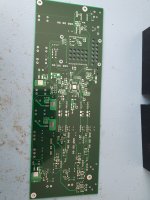 20210928_113513.jpg471.1 KB · Views: 80
20210928_113513.jpg471.1 KB · Views: 80 -
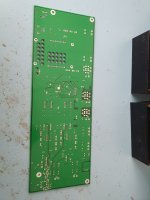 20210928_113521.jpg449.2 KB · Views: 79
20210928_113521.jpg449.2 KB · Views: 79 -
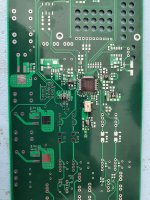 20210928_122825.jpg480.4 KB · Views: 84
20210928_122825.jpg480.4 KB · Views: 84 -
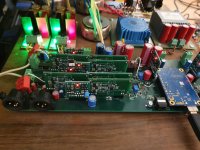 20210922_191006.jpg498.4 KB · Views: 81
20210922_191006.jpg498.4 KB · Views: 81 -
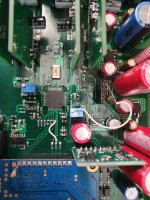 20210928_113443.jpg564.3 KB · Views: 83
20210928_113443.jpg564.3 KB · Views: 83 -
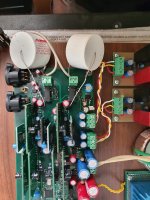 20210928_123440.jpg559.6 KB · Views: 85
20210928_123440.jpg559.6 KB · Views: 85 -
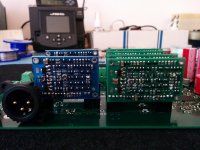 IMG_20190609_201648.jpg375.7 KB · Views: 67
IMG_20190609_201648.jpg375.7 KB · Views: 67 -
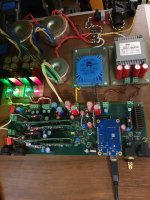 viber_image_2021-09-23_11-28-27-518.jpg277.3 KB · Views: 69
viber_image_2021-09-23_11-28-27-518.jpg277.3 KB · Views: 69 -
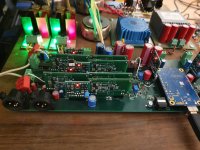 viber_image_2021-09-23_11-28-36-922.jpg221.4 KB · Views: 65
viber_image_2021-09-23_11-28-36-922.jpg221.4 KB · Views: 65
I continue with the next flagman DAC CS43198.
Here is first prototipe with 16 stereo dacs. Total of 32 chanels (16 in paralel for left channel and 16 for right channel).
I also draw new board with single CS43198 and option for integral or discrete opamp.
Here is first prototipe with 16 stereo dacs. Total of 32 chanels (16 in paralel for left channel and 16 for right channel).
I also draw new board with single CS43198 and option for integral or discrete opamp.
Attachments
-
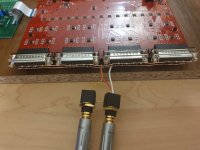 viber_image_2021-12-07_19-13-36-734.jpg238.2 KB · Views: 61
viber_image_2021-12-07_19-13-36-734.jpg238.2 KB · Views: 61 -
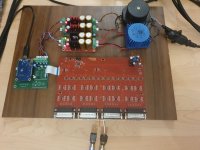 viber_image_2021-12-07_19-13-42-911.jpg219 KB · Views: 65
viber_image_2021-12-07_19-13-42-911.jpg219 KB · Views: 65 -
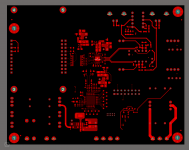 viber_image_2022-02-24_21-32-57-973.png87.1 KB · Views: 57
viber_image_2022-02-24_21-32-57-973.png87.1 KB · Views: 57 -
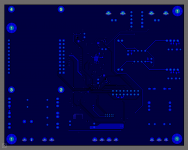 viber_image_2022-02-24_21-33-06-061.png78.1 KB · Views: 66
viber_image_2022-02-24_21-33-06-061.png78.1 KB · Views: 66 -
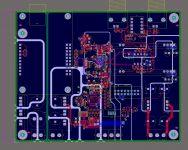 viber_image_2022-02-24_21-33-16-056.png221.9 KB · Views: 64
viber_image_2022-02-24_21-33-16-056.png221.9 KB · Views: 64 -
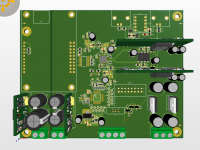 viber_image_2022-02-24_21-33-26-665.png225.3 KB · Views: 63
viber_image_2022-02-24_21-33-26-665.png225.3 KB · Views: 63
- Home
- Source & Line
- Digital Line Level
- Buffalo III upgraded with ES9028Pro